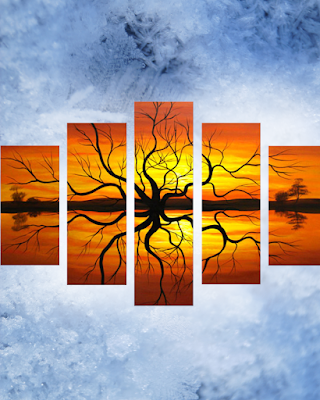SUNSET PAINTING
There are a tonne of tutorials on you-tube and wiki-how for watercolour, but a few quick tips would be to:
# Have a general idea of the sun and horizon.
# Use a flat sable brush to quickly wet the paper from the top. Try to fill the water such that when you tilt it, the water slides down.
# Quickly paint the sun and the sky: Select your colours according to the hue you wish to use (warm or cool). Beginning with the sun (chrome in reddish orange or yellow), [let it spread, we can fix it afterwards] Use lemon yellow next in the sun's immediate vicinity. Orange follows, with inky blue-black at the top and corners. Make sure the paints have a watery consistency so they can blend together and create a seamless landscape. Work quickly to prevent the water from drying out. [Make sure the sun's semi-circle is still uniformly coloured and tidy
# Allow the paper to dry to the point where it is moist but not wet [watch out for a linty paper surface]. If you want to add clouds, do so now. At this level of moisture, the clouds should be thin, allowing for significant restricted spreading. The extra clouds should be thin and bluish grey in colour because the method should already provide the impression of clouds.
# The paper should now have a more dry-damp consistency. The foreground silhouettes should be painted in black and blue.
PAINT A SUNSET WATER
Because of the shifting light, painting sunsets can be challenging. The most crucial element in a landscape painting is light. It is possible to discern between the many colours, shapes, and textures thanks to light. Even when you are painting in the same location, good light is extremely difficult to achieve because it varies over time. One of the issues you can run into is that the sky is blue at morning, gradually grows darker until sunset, and then turns orange. This implies that the sky appears differently depending on the time of day. In a painting, in order to accomplish this result, You must be able to blend various colours correctly. The scene's action should influence the colours you choose. Consider the colours in your environment when you paint. The outcome will be impacted by these colours. Sometimes it's difficult to decide whether to depict a red object in a painting of a sunset.
HOW LONG A SUNSET PAINTING DRY
Depending on how thickly the paint was put, oil paint may take a while to completely dry. I've attended vernissages when the heavy impasto on the artwork wasn't really dry at all, and there was a definite linseed oil scent.
PAINT SUNSET WITH OIL
Look at the painting primarily for two things. Diffuse light and light that is reflected. Use transparent paint for the reflected light and thin glazes for the light that is coming through the atmosphere. Start by painting thinly.
Consider looking at famous sunset painters' artwork as well.
In my mind, Sir Edwin Church is the artist who comes to mind first since he, true to his name, portrayed landscapes as the American church and sunsets as stained glass.
Which should give you a hint: create an ambience reminiscent of stained glass.
The impact of seeing his works in person as opposed to online is HUGE. Find a museum in your area that houses one of his paintings if you can.
Keep in mind that some pigments are more opaque than others while selecting them.
An illustration. You'll need Indian Yellow to create that translucent yellow, which was originally produced in India from the urine of cattle that were exclusively fed marigold petals.
You'll need the most strong orange you can find to merge the yellow into the orange. Daniel Smith's Pyrol Orange is what I use.




0 Comments